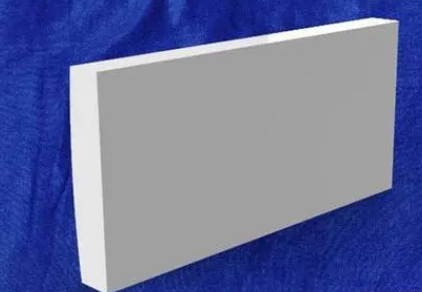Ceramic PCB, its characteristics and introduction
If you are looking for electronic products that have high frequency and high insulation properties in a high-voltage and high-temperature environment and are small in size, then metal core PCBs may be a good choice. Are there other options besides metal cores? The answer is yes: that is ceramic PCBs. So what is a ceramic PCB? If you want to know more about ceramic PCBs, please continue reading.
What is a Ceramic PCB
Ceramic PCB, also known as "ceramic hybrid circuit device". It is a printed circuit board made of a ceramic material matrix or substrate (usually an inorganic dielectric) instead of a traditional glass fiber or epoxy resin matrix. It is an electronic circuit board composed of a thin insulating layer of ceramic material and metal components.

Ceramic PCB Slice Diagram
After looking at the structure diagram above, you probably have a little understanding of it. Here is a brief introduction to the basic structure of ceramic PCBs, which can provide an in-depth understanding of why they have such excellent performance.
Typically, ceramic PCBs are made of 96-98% aluminum oxide (Al2O3), aluminum nitride (AIN) or beryllium oxide (BeO). Although for thin film or thick film technology, silver palladium (AgPd) is preferably used as a conductor material.
For requirements of direct copper bonding, copper is used. Ceramic PCBs can operate in a temperature range of -55°C to +850°C and have excellent thermal conductivity, ranging from 24-250 W/mK, depending on whether the ceramic material is aluminum oxide, aluminum nitride or beryllium oxide. Ceramic materials have excellent compressive strength, exceeding 7000 N/cm2, and a breakdown voltage of up to 28 KV/mm for a thickness of 1.0mm.
What are the characteristics of ceramic PCB?
1. High temperature tolerance: Ceramic PCB boards can work stably at extreme temperatures from -50°C to 300°C, and are suitable for applications that require extreme working environments, such as the aerospace field.
2. Excellent thermal conductivity: The thermal conductivity of DPC ceramic substrates is very good, usually between 2-3w/m·K. This high thermal conductivity can effectively dissipate heat and ensure stable operation of components at extreme temperatures.
3. Material stability: Using ceramic as the substrate material, ceramic PCB boards have excellent dimensional stability and are not easily deformed by temperature fluctuations and humidity changes. The thermal expansion coefficient of ceramic substrates is very close to that of silicon wafers, which can effectively reduce the stress caused by temperature changes and ensure the dimensional stability of components.
4. Excellent insulation performance: Ceramic PCB boards have good insulation performance, which can effectively reduce mutual interference between circuits and ensure the reliability of electronic equipment.
5. Good corrosion resistance: DPC ceramic substrates have good corrosion resistance and can operate stably for a long time in acidic, alkaline and high temperature environments. This feature makes DPC ceramic substrates have a wide range of application potential in special industrial fields.
Summary: The Advantages of Ceramic PCB in Electronics
Due to its excellent performance, ceramic substrates have been widely used in electronic device manufacturing, lighting, power electronics, electronic heat dissipation and other fields.
In the manufacture of electronic devices, ceramic substrates are often used to manufacture high-temperature and high-power electronic components such as LED packaging substrates and power modules. In the field of lighting, ceramic substrates can be used as heat dissipation carriers for high-power LED lamps to ensure the stable operation of LEDs.
In the field of power electronics, ceramic substrates can be used as insulating substrates for power modules. They have excellent thermal conductivity and insulation properties, which can effectively improve the power density and efficiency of power modules.
Basic material composition of ceramic PCBs
There are many kinds of materials for making ceramic PCBs. When selecting ceramic materials, the two basic characteristics that generally need to be paid attention to are the thermal conductivity and thermal expansion coefficient (CTE) of the PCB. Commonly used materials are: aluminum oxide or aluminum oxide (Al₂O₃), aluminum nitride (AlN), beryllium oxide or beryllium oxide (BeO), silicon carbide (SiC) and boron nitride (BN), of which the most widely used are three: aluminum oxide (Al₂O₃), aluminum nitride (AIN), beryllium oxide (BeO).

Aluminum Nitride (AlN) Ceramic Substrate Fabrication
First of all, the Al₂O₃ substrate has good comprehensive performance and is currently the most mature in application. Moreover, the raw materials of Al₂O₃ are abundant. It is an inorganic compound also known as alumina. It is an advanced material made of oxygen and aluminum. It is usually white, but varies depending on purity.
The color can be pink to almost brown. This compound is odorless and in the form of a crystalline powder, but it is insoluble in water. It is relatively cheap and has good insulation, chemical stability and adhesion to metals. It is the most commonly used ceramic substrate for power devices.
Beryllium oxide (BeO) or beryllium oxide, also known as dextran or oxidized glucose in history. As the name implies, it is derived from beryl or the mineral beryl. It is a solid crystalline inorganic compound that is white in color.
The most outstanding performance of this ceramic substrate material is its high thermal conductivity. This refractory compound has a high melting point of 2506.85 °C to 2575 °C, a boiling point of 3905 °C, and a CTE of 7.4 to 8.9 x 10-6/K. Therefore, it is widely used in the electronics industry and is a valuable resource. Other industries also benefit from it due to its high melting point, excellent thermal conductivity, and good electrical resistance.
For more than 60 years, beryllium oxide has demonstrated excellent chemical and thermal stability in challenging conditions and harsh environments. In applications where PCBs are exposed to high temperatures or high-density PCBs with limited space, BeO can be used to provide air or liquid cooling. It is 6 to 10 times that of aluminum oxide. Unfortunately, BeO ceramic powder is highly toxic.
Although SiC ceramics have high thermal conductivity, they have high dielectric loss and low breakdown voltage, which is not conducive to application in high-frequency and high-voltage working environments.
AlN ceramic substrates have the characteristics of high thermal conductivity and good insulation, and are currently the most commonly used ceramic substrates in Si-based semiconductor materials. However, the low mechanical strength, easy deliquesce and high manufacturing cost of AlN ceramics limit the development of AlN substrates.
Si3N4 ceramics are the ceramic substrate materials with the best comprehensive performance, with a thermal conductivity of 90-120W/(m·k), a thermal expansion coefficient of 3.2×10-6/℃, and excellent mechanical strength, good chemical stability and thermal shock resistance.
At the same time, the thermal expansion coefficient of Si3N4 ceramic substrates is close to that of the third-generation semiconductor substrate SiC crystal, which makes it more stable in matching with SiC crystal materials, making Si3N4 the first choice for high thermal conductivity substrate materials for third-generation SiC semiconductor power devices.
Applications of Ceramic PCB in High-Tech Industries
1.1 Aerospace and Defense
Ceramic PCB has good stability and runs smoothly in high temperature and high vibration environments, meeting the requirements of aerospace equipment for long life and high reliability.
1.2 Application of Satellite Components
Ceramic PCB is also widely used in satellites and space exploration equipment due to its excellent insulation performance and radiation resistance.
1.3 High-frequency Application
The dielectric properties of ceramic PCB are suitable for high-frequency equipment, which improves the performance of radar and communication systems.
2. Medical Equipment
2.1 High Precision Requirements
The precision and stability of ceramic PCB make it perform well in medical imaging equipment, meeting the requirements for high precision and low distortion.
2.2 Use in Diagnostic Equipment
In diagnostic equipment such as CT and MRI, ceramic PCB provides stable performance and reliability, which helps to improve the quality of diagnosis.
2.3 Durability in Sterilization Processes
Ceramic PCBs are resistant to high temperatures and chemical corrosion, and are suitable for equipment that requires repeated sterilization, ensuring the safe operation of medical equipment in a sterile environment.
3.LED Industry
3.1 LED Lighting: Ceramic PCBs are used as substrates for LED modules
Summary: Due to the excellent thermal management and strong stability of ceramic PCBs, ceramic PCBs are generally used in some high-pressure, high-temperature, and highly corrosive environments to ensure safe and stable operation of equipment.





